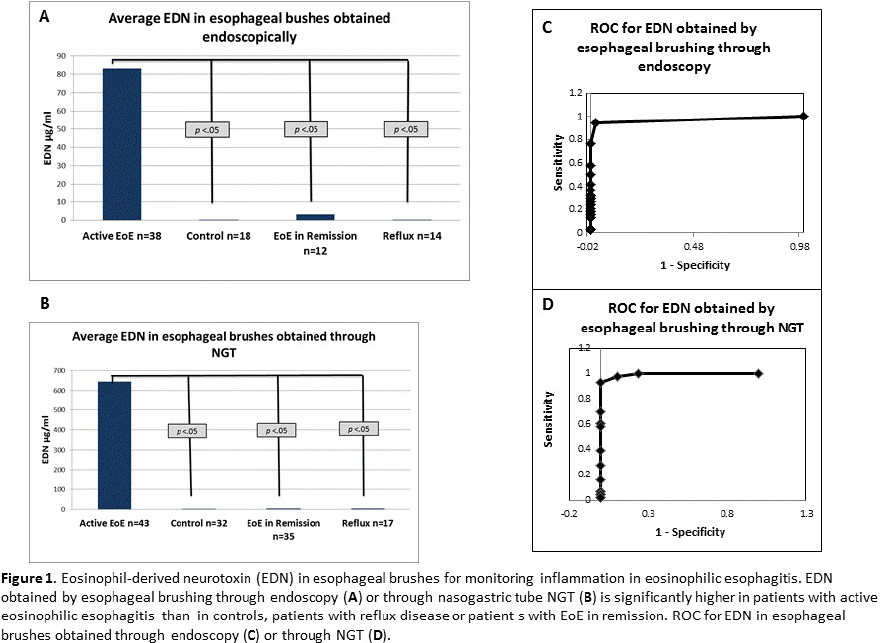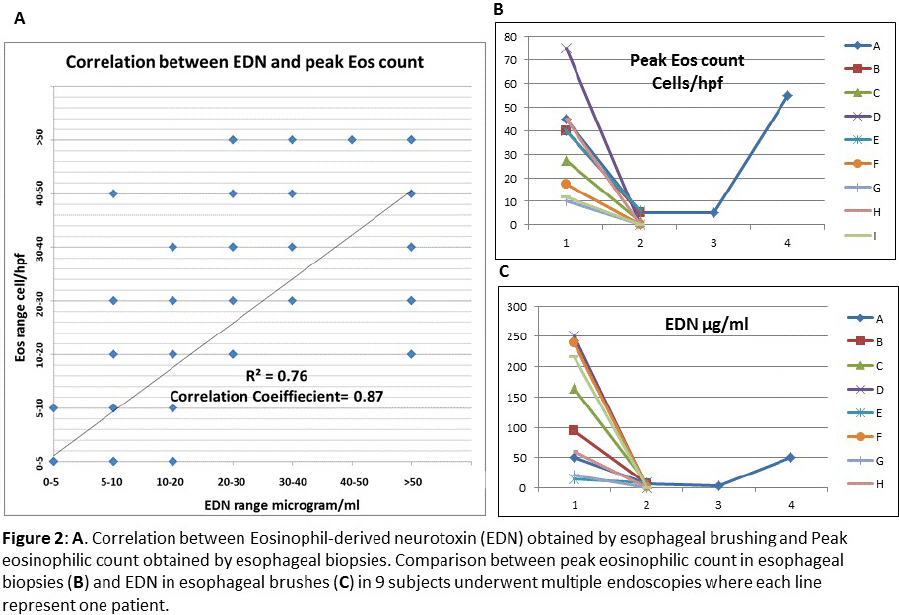|
|
Back to 2017 Program and Abstracts Blind Esophageal Brushing is Safe and Accurate for Monitoring Inflammation in Children with Eosinophilic Esophagitis Yamen Smadi, Chirajyoti Deb, Khaled Bittar, Jeffrey Bornstein, Karoly Horvath, Devendra Mehta Arnold Palmer Hospital for Children, Orlando, FL
BACKGROUND: Children with Eosinophilic Esophagitis (EoE) require frequent evaluation of mucosal inflammation. Obtaining esophageal samples by inserting an esophageal brush through a nasogastric tube (NGT) has been used safely and effectively in diagnosing esophageal cancer and candidiasis. AIM: We hypothesized that measuring Eosinophil-derived neurotoxin (EDN) in samples obtained by esophageal brushing through NGT would be safe and accurate in monitoring the inflammation in pediatric patients with EoE. METHODS: We conducted a prospective case control study in children of less than eighteen-year of age that are scheduled for routine Esophagogastroduodenoscopy (EGD). Patients with history of esophageal anatomical malformations were excluded. Initially, we obtained esophageal samples using esophageal cytology brushes (Kimberly-Clark # 60314) inserted through the endoscope and later on, we performed esophageal brushing blindly using same cytology brushes inserted through a 10Fr NGT (Cortrack # 20-9431TRAK2) just before the scheduled endoscopy. We measured EDN by ELISA (MBL # 7630) with serially diluted samples in duplicates. Receiver operating characteristics (ROC) curves were constructed to calculate area under the curve (AUC), sensitivity (SN) and specificity (SP). RESULTS: We collected 209 esophageal brushing samples (n = 82 through EGD and n = 127 blindly through NGT) from 94 patients (59 males; mean age 10 years). EDN in esophageal brushing obtained endoscopically or through NGT was significantly higher in active eosinophilic esophagitis (n=81) than in control (n=50), gastroesophageal reflux disease (31) or eosinophilic esophagitis in remission (n=47) (p=0.003) [Figure-1]. EDN equal or above 10 microgram/ml of esophageal mucosal brush is very sensitive and specific in diagnosing active EoE whether obtained endoscopically (SN=0.94, SP=0.97, AUC=0.97) or blindly through NGT (SN=0.97, SP=0.89, AUC=0.99) [Figure-1]. EDN measured in esophageal biopsies were elevated in patient with active EoE only and the level correlated with EDN measured in brush samples (CC=0.97; R2=0.93). Levels of EDN in esophageal brushes correlates with peak eosinophilic count in esophageal biopsies(CC=0.87; R2 =0.76) [Figure-2]. EDN in esophageal samples obtained blindly through NGT was higher than that obtained through endoscopy in patients with active EoE (p<0.05); but this was not signifiicant in control (p=0.1). Patients who underwent brushing through NGT had no complications. CONCLUSION: Blind esophageal brushing through NGT, a less invasive process compared to EGD, is safe and well tolerated to obtain esophageal samples in children. EDN measured in esophageal brushing samples obtained endoscopically or blindly through NGT is highly sensitive and specific for monitoring inflammation in children with eosinophilic esophagitis. Back to 2017 Program and Abstracts |
||||||||||||
© 2025 Society for Surgery of the Alimentary Tract. All Rights Reserved. Read the Privacy Policy.



